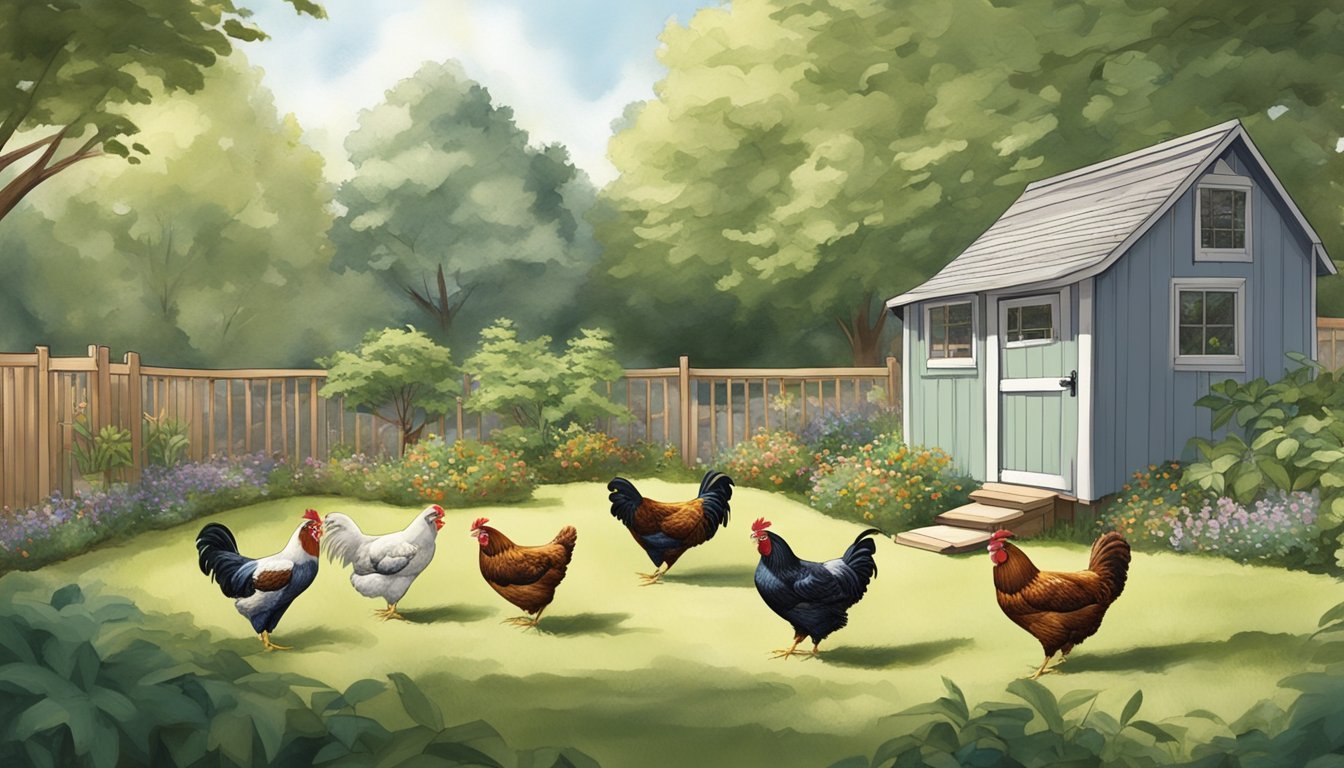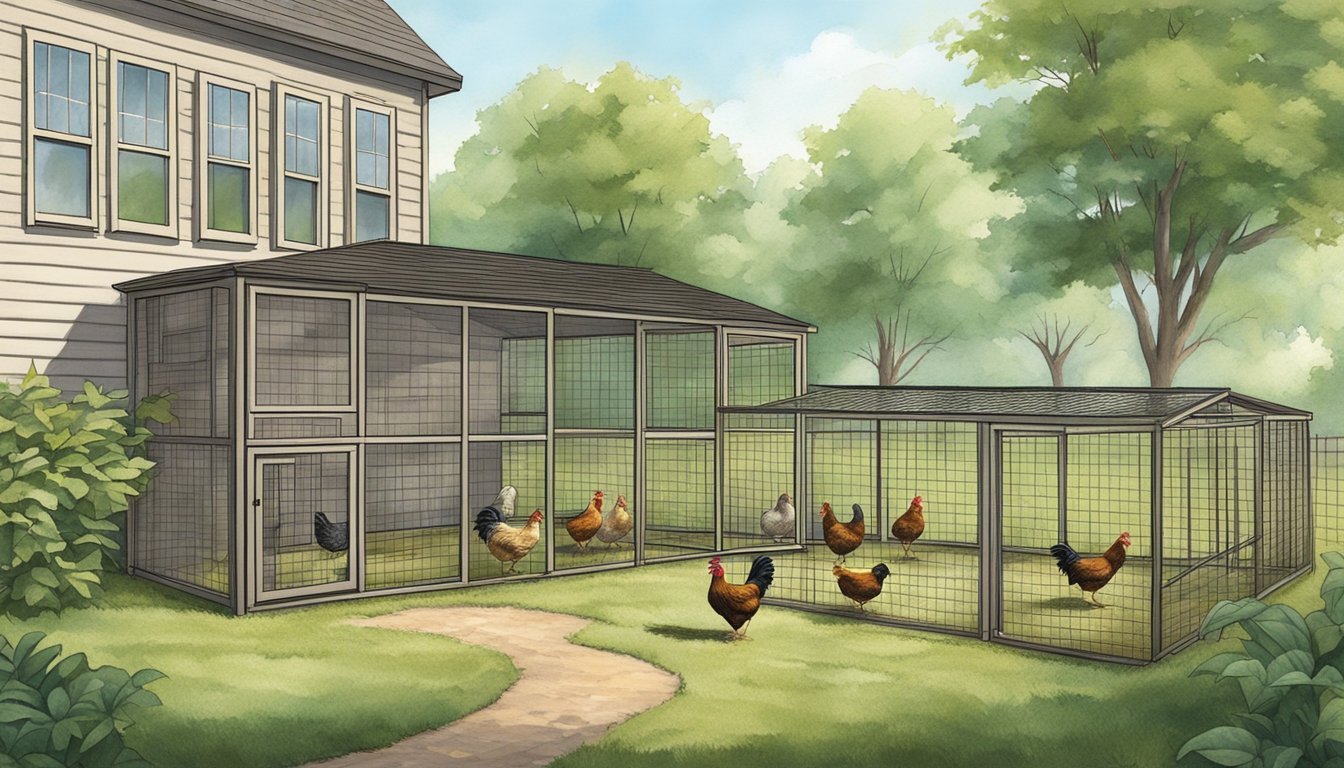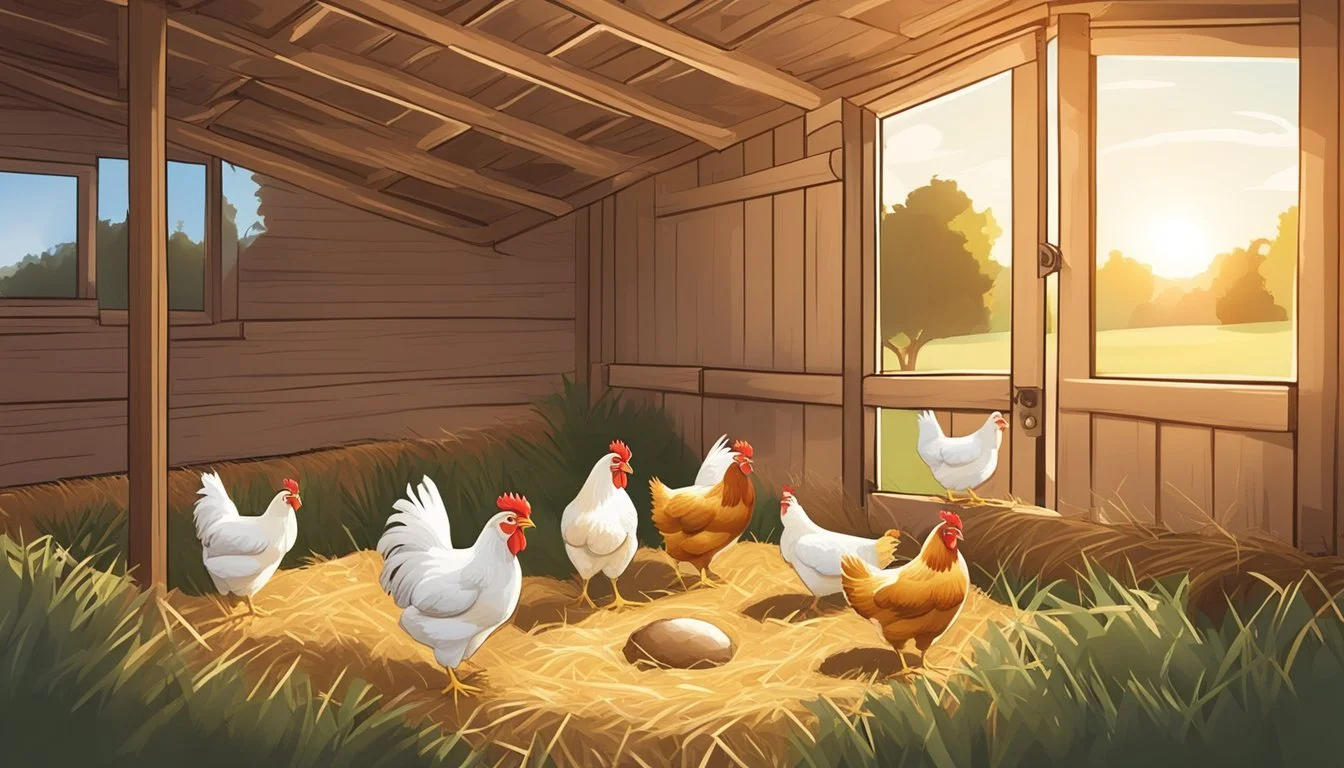Raising Backyard Chickens in Bloomington, MN
A Starter Guide for Urban Poultry Enthusiasts
Raising backyard chickens has become a popular hobby in Bloomington, MN, offering residents a way to connect with their food source and enjoy fresh eggs. The city acknowledges this growing interest and has set clear guidelines to ensure that the practice is carried out responsibly. Within the boundaries of Bloomington, only single-family and two-family residential properties are permitted to keep up to four hen chickens. This regulation complements the existing allowance for a maximum of four domestic animals or pets per residence, creating an opportunity for urban poultry enthusiasts to diversify their small-scale homesteads.
To uphold community standards and animal welfare, the city enforces specific ordinances that potential chicken keepers must follow. These rules encompass coop construction, placement, and maintenance—all designed to minimize nuisance and maintain hygiene standards. As with any pet or domestic animal, care for backyard chickens requires a commitment to their health and well-being, with an understanding of local regulations. Residents of Bloomington choosing to embark on this venture can benefit from an array of local resources, including social media groups and educational materials provided by the University of Minnesota Extension, which guide beginners through the essentials of small flock management and disease prevention.
While the activity of raising backyard chickens in the city is embraced, it is not without its restrictions and challenges. Bloomington's approach reflects a balance between accommodating the interests of chicken enthusiasts and addressing the concerns of the wider community. This measured perspective ensures that residents can enjoy the pleasures of raising poultry without compromising the integrity of the neighborhood environment.
Getting Started with Backyard Chickens
Embarking on the journey of raising backyard chickens requires careful planning and compliance with local regulations. Selecting suitable breeds and structuring the living space for the chickens are pivotal steps.
Understanding Local Ordinances
The city of Bloomington, MN mandates specific rules for keeping backyard chickens. Prospective chicken owners must adhere to these ordinances to avoid penalties. Notably, the city stipulates a setback requirement, which could limit the feasibility of chicken keeping in smaller yards. Residents should check the latest guidelines, such as housing limitations and property line setbacks, by contacting the Bloomington city officials or visiting the city's website.
Choosing the Right Breeds
When selecting chicken breeds, one must consider the Minnesota climate and their own productivity expectations for egg laying or meat. Cold-hardy breeds, such as Plymouth Rocks or Wyandottes, are suitable for Bloomington's weather. Beginners often opt for docile hens like Buff Orpingtons, which are known for their friendly nature and consistent egg production.
Planning Your Space
Adequate housing is crucial for chicken well-being and protection from predators. A chicken coop should provide:
Shelter: Insulated and ventilated to weather Minnesota winters and summers.
Space: At least 3 square feet per chicken if they have outdoor access; more if they do not.
Safety: Predator-proof fencing and secure closures at night.
An enclosure or fenced run allows chickens to forage and exercise safely. Ensure the enclosure:
Size: Offers 10 square feet per chicken.
Structure: Includes overhead coverage to prevent aerial predators from accessing the space.
Security: Buries the base to deter digging predators.
By understanding ordinances, selecting suitable breeds, and creating a conducive space, residents of Bloomington, MN, can start their backyard chicken endeavor competently.
Chicken Coop Essentials
When raising backyard chickens in Bloomington, MN, the coop serves as the central habitat offering protection, sound environment, and proper conditions for poultry. Coops must balance space, safety, and climate management for optimal poultry health.
Design and Size
A chicken coop must provide sufficient space to prevent overcrowding and ensure a healthy living environment. As a rule of thumb, each chicken requires at least 3-4 square feet inside the coop and 8-10 square feet in an outdoor run. The coop design should also allow for easy cleaning, egg collection, and maintenance.
Space Requirements:
Inside coop: 3-4 square feet per chicken
Outdoor run: 8-10 square feet per chicken
Security Measures
Safety in a chicken coop is non-negotiable due to threats from local predators such as raccoons, hawks, owls, rats, and cats. Use sturdy materials and construction to deter predators. A secure chicken coop should include:
Walls and floors: Solid, impenetrable surfaces without gaps
Doors and windows: Properly latched and reinforced with predator-proof latches
Fencing: Heavy-duty metal mesh to prevent predators from entering
Ventilation and Insulation
Proper ventilation ensures fresh air circulation, reducing ammonia levels and moisture that can cause respiratory problems and disease. Insulation is equally important to protect chickens from cold weather. Features should include:
Ventilation: Ample air flow through vents or windows, secured with predator-proof mesh
Insulation: Materials to maintain a steady temperature within the coop, protecting against temperature extremes
Flock Composition and Dynamics
Creating a harmonious backyard chicken flock in Bloomington involves careful consideration of flock composition and dynamics, particularly when introducing new chickens and managing the hen to rooster ratio.
Introducing New Chickens
When new chickens are added to a backyard flock in Bloomington, they should be introduced cautiously. Quarantine new birds for at least 30 days to monitor for diseases. After quarantine, introduce them gradually to the existing flock to reduce stress and prevent bullying. The pecking order will need to re-establish, and it is not uncommon for older chickens to avoid or chase away new pullets until they find their place in the hierarchy.
Day 1-3: Keep newcomers in a separate but visible enclosure.
Day 4-7: Allow mingling during supervised free-range time.
Day 8+: Monitor flock interactions as they cohabit.
Hen to Rooster Ratio
The ideal hen to rooster ratio for a backyard flock is generally about 10 hens for every rooster. This balance helps prevent over-mating, which can stress hens and cause injuries. Be mindful that having more than one rooster can lead to fights unless the flock is quite large, or they are raised together from a young age.
Max Roosters: Generally, 1-2 roosters for most backyard flocks.
Management of the hen to rooster ratio is essential to ensure a peaceful and productive backyard flock.
Chicken Care and Daily Maintenance
Maintaining the health and happiness of backyard chickens in Bloomington, MN requires consistent daily care, focusing on proper nourishment, water availability, cleanliness, and vigilant observation to prevent health issues.
Feeding and Nutrition
Chickens require a balanced diet rich in protein, vitamins, and minerals to thrive. An adult hen's diet typically includes:
Layer feed: Provides essential nutrients.
Grit: Helps with digestion.
Owners should ensure chickens have access to chicken feed formulated for their specific life stage—starter, grower, or layer.
Clean Water Supply
Chickens must always have access to clean, fresh water. Waterers should be:
Refilled daily.
Kept clean to prevent disease.
Change water regularly and scrub the containers to deter algae and bacterial growth.
Regular Cleaning and Sanitation
Coops must be kept clean to prevent the spread of disease and parasites:
Perform daily spot cleaning.
Replace bedding weekly.
Designate tools for coop cleaning to avoid cross-contamination.
Observation for Health and Behavior
Daily observation helps in the early detection of potential health issues. Look for signs of:
Changes in eating or laying habits.
Signs of common diseases or parasites.
Promptly separate any sick chickens to prevent the spread of illness.
Health and Veterinary Care
In raising backyard chickens, maintaining their health is crucial. Bloomington, MN residents must be informed about common diseases, how to handle emergencies, and implement strict biosecurity to protect their flocks.
Common Diseases and Prevention
Salmonella and avian influenza are two significant diseases that can affect backyard chickens. Salmonella can be prevented through proper sanitation and handling practices. Highly pathogenic avian influenza (HPAI) requires stringent controls to prevent an outbreak. Vaccinations, when available, regular health check-ups by a veterinarian, and keen observation for symptoms are essential for disease prevention.
Vaccination: Consult with a veterinarian to establish a vaccination schedule.
Observation: Regularly monitor for signs of disease, including lethargy, respiratory distress, or unexplained deaths.
Injury and Emergency Situations
Injury in backyard chickens can occur due to predators, pecking order disputes, or accidents. In such cases, immediate attention from a veterinarian may be necessary. Owners should have a first aid kit for chickens and know basic wound care to manage minor injuries.
First Aid Kit Essentials:
Antiseptic solution
Wound ointment
Bandages
Tweezers
Biosecurity Measures
Biosecurity is a set of preventative measures designed to reduce the risk of disease entering or spreading within a poultry flock. Key biosecurity practices include:
Isolation: Keep new birds isolated for at least 30 days before introducing them to the flock.
Traffic Control: Limit access to your chickens and employ designated clothing and footwear when handling them.
Sanitation: Regularly clean and disinfect equipment and housing to prevent the buildup of disease agents.
Implementing these measures helps prevent the spread of diseases, such as salmonella and avian influenza, safeguarding not only the flock's health but also public health.
Egg Production and Nesting
In the colder climates of Bloomington, MN, backyard chicken keepers must focus on the setup of nesting boxes and managing laying issues to ensure a steady supply of fresh eggs. Specific breeds like Orpington, Rhode Island Red, Wyandotte, and Ameraucana are well-suited for egg laying in these conditions.
Setting Up Nesting Boxes
A well-designed nesting box is crucial for optimal egg production. Each box should measure roughly 12 inches by 12 inches, with one box for every three to four hens. The nesting area should be kept clean, dry, and filled with soft bedding, such as pine shavings. Ideally, these boxes should be placed in a quiet, darker part of the coop to encourage laying.
Collecting and Storing Eggs
Eggs should be collected daily to ensure freshness and hygiene. Once collected, they can be stored at a consistent temperature to maintain quality. Bloomington residents might need to adjust storage methods depending on the time of year, due to varying indoor and outdoor temperatures.
Managing Laying Issues
Laying issues can arise from stress, which may be caused by inadequate coop conditions or extreme weather. To combat this, ensure chickens have proper insulation against the cold Minnesota winters. Additionally, monitor each hen's laying patterns to identify any potential health problems early. Consistent laying is typically seen in healthy, stress-free birds.
Raising Chickens Through the Seasons
When raising backyard chickens in Bloomington, MN, understanding seasonal care is essential. Chickens require different maintenance routines as the seasons change, from protecting them against the summer heat to preparing them for the harsh Minnesota winters.
Summer Care
During the summer months, chickens can suffer from heat stress. It's critical to provide ample shade and fresh water to keep them cool. Owners should ensure the coop is well-ventilated, utilizing fans if necessary. Consider adding electrolytes to the water during extreme heat to prevent dehydration.
Preparing for Cold Winters
Cold winters in Bloomington require that chickens have a dry and draft-free coop. Insulating the coop while maintaining adequate ventilation can prevent moisture build-up. Heat lamps can be used judiciously to provide warmth but should be installed safely to avoid fire hazards. Ensuring a continuous supply of unfrozen water is also paramount.
Managing Molting
Molting, usually occurring in the fall, is a natural process where chickens lose their old feathers to regenerate new ones. During this time, they need extra protein. Feed adjustments, such as increasing the percentage of protein in their diet with feed supplements or protein-rich treats, can help support feather regrowth and maintain their health.
By paying close attention to these seasonal needs, backyard chicken owners in Bloomington can ensure their flock remains healthy and productive year-round.
Additional Considerations
When raising backyard chickens in Bloomington, Minnesota, one must attentively manage several factors including local predators, waste sustainability, community involvement, and the selection of chicken breeds suitable for either eggs, meat, or both.
Dealing with Predators and Pests
In Bloomington, typical predators include raccoons, foxes, and birds of prey. Protecting chickens from such threats is critical. Fencing must be sturdy and secure, with hardware cloth covering any vents or wide openings. Coop design should prevent digging or forceful entry, especially at night when predators are most active. Vigilance against pests like rats and mice, attracted to chicken feed, is essential. Pest-proof containers and regular cleaning can help mitigate this issue.
Sustainability and Composting
Backyard chicken enthusiasts in Bloomington can practice sustainability by composting. Chicken manure, rich in nitrogen, can be a valuable addition to compost heaps, contributing to a nutrient-rich soil amendment for gardens. It is advised to allow manure to compost for at least six months before use, ensuring safer handling and minimizing the risk of pathogens. Here's a simple guideline for composting:
Stage Action Collection Regularly clean and collect manure and bedding. Composting Pit Combine with carbon-rich materials like leaves or straw. Maintenance Turn heap periodically to aerate and speed decomposition. Utilization Apply to garden beds after proper composting time.
Engaging with the Chicken Community
Connecting with local chicken keepers can offer invaluable support and knowledge. Bloomington residents may join online forums, attend city council meetings concerning backyard chickens, or even participate in community events geared towards poultry enthusiasts. These interactions can lead to shared tips, equipment trades, and a well-supported community fostering a more vibrant urban agriculture scene.
Exploring Meat and Dual-Purpose Breeds
For those interested in meat production, broiler breeds like Cornish Cross are popular for fast growth and substantial meat yield. However, dual-purpose breeds such as Plymouth Rocks or Orpingtons can provide both meat and eggs, albeit with a slower growth rate for meat production. Selecting the right breed depends on space, budget, and personal preference regarding the balance of egg and meat production.









